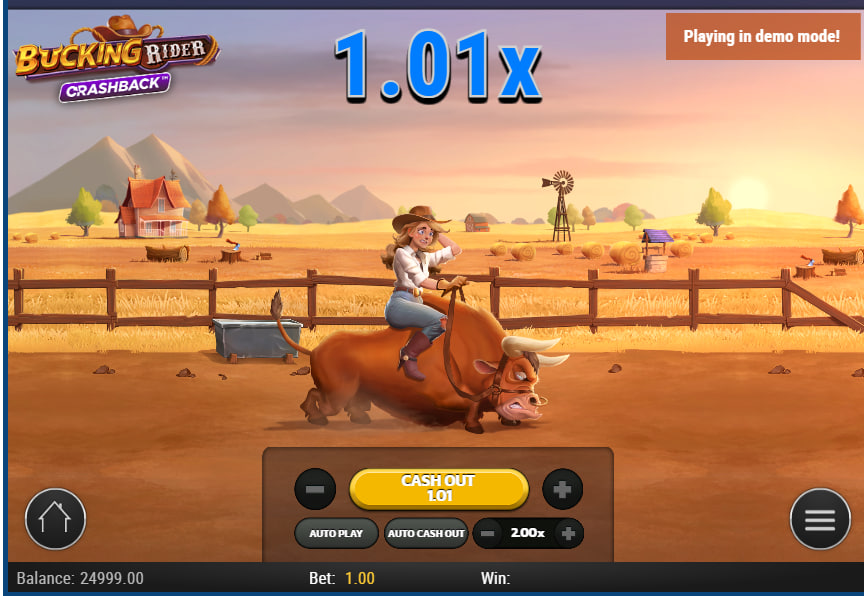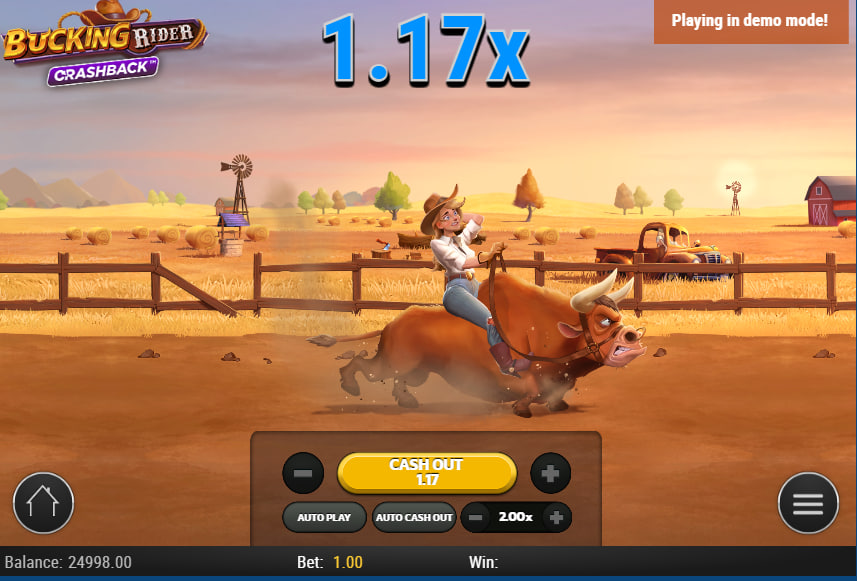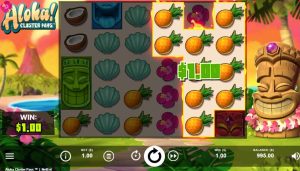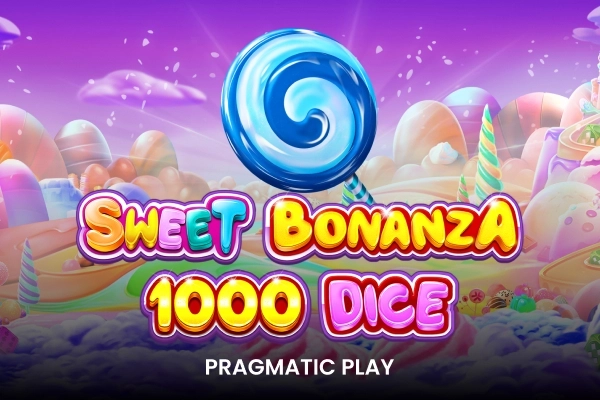Bucking Rider, developed by Play’n GO, delivers a high-stakes gambling experience set against a minimalist Wild West backdrop. This crash-style game diverges from traditional slot mechanics, focusing on the escalating tension of a rising multiplier. Players place bets and strategically decide when to cash out before the unpredictable “crash” occurs, potentially forfeiting their wager. The core gameplay emphasizes rapid decision-making and risk assessment. Bucking Rider incorporates an Auto Cash Out feature for pre-set risk management and a unique Crashback mechanic, offering a second chance at a cost, should players cash out early. The maximum win multiplier reaches an impressive 5000x the initial bet. Although visually austere, the game prioritizes functional clarity for fast-paced engagement. Bucking Rider presents a compelling alternative to conventional slots, appealing to those seeking immediate action and strategic betting.
Play’n GO, a developer renowned for its diverse portfolio and often innovative approach, presents Bucking Rider. This game departs from the typical slot format, opting instead for a high-tension, fast-paced crash-style experience. It evokes the spirit of the Wild West, but strips away elaborate narratives and intricate symbol designs in favor of immediate, reactive gameplay. Bucking Rider throws players into a digital arena where timing and nerve are paramount, creating a uniquely engaging, if somewhat stark, gambling proposition. It is a title less concerned with spinning reels and paylines, and more focused on the rising adrenaline of a multiplier climbing ever higher.

Gameplay Dynamics and the Crashback Innovation
Bucking Rider operates on a fundamentally different principle than conventional online slots. Instead of aiming for symbol combinations across paylines, the core objective is to cash out your bet before the game “crashes”. Each round begins with a multiplier starting at 1x, which then progressively increases – often rapidly, but unpredictably. Players place their bets before each round commences, and then watch as the multiplier climbs. The tension mounts as the multiplier value grows, presenting increasingly lucrative potential payouts. However, at any moment, the game can “crash,” meaning the multiplier abruptly stops and players who haven't cashed out lose their initial stake for that round.
The core decision revolves around timing: cash out too early, and you secure a smaller win, potentially leaving significant profit on the table. Wait too long, and the crash will eliminate your winnings for that round entirely. This dynamic creates a compelling push-and-pull between greed and caution, making each round a miniature gamble in itself.
Bucking Rider incorporates several features that enhance this core gameplay loop. The interface, as seen in provided screenshots, is clean and functionally oriented. Prominent “+/-” buttons allow for quick bet adjustments, which is critical in a fast-paced game where prompt decisions are essential. A “Cancel” button is available to withdraw bets before a round begins, offering a level of flexibility. Crucially, an “Auto Play” function allows players to pre-set a number of rounds to be played automatically, streamlining the experience for those seeking sustained engagement.
However, the most intriguing aspect of Bucking Rider is undoubtedly its Crashback feature. This mechanism introduces a layer of strategic depth not commonly seen in crash-style games. If a player cashes out ‘early’, the game, for a limited period, provides an option to return to the same round using Crashback. The ‘cost’ for utilizing Crashback is defined as the difference between the previous cashout value and the current, higher multiplier value at the point of reactivation. This implies Crashback is essentially a second chance, but one that comes at a calculated cost, dependent on how much further the multiplier has climbed since the initial cash out. This feature encourages players to reconsider their initial decisions and potentially capitalize on missed opportunities, adding a layer of post-decision engagement rarely found in similar games.
Thematic Minimalism and Visual Design
Bucking Rider opts for a visually austere presentation, consistent with the rapid-fire nature of its gameplay. The screenshots suggest a UI that prioritizes clarity and immediate access to controls over elaborate graphics. The background appears to be a textured brown, perhaps intended to evoke dusty earth or sun-baked terrain of the Wild West. A stylized bull skull logo features intermittently, reinforcing the Western theme in a subtle way, without dominating the screen.
The font used for game elements such as bet values, multipliers, and function labels is bold and highly legible, ensuring crucial information is readily apparent, even amidst the quickening pace of gameplay. The button design is functional and clearly delineated, employing contrasting colors – green for ‘Bet,’ yellow for ‘Cash Out,’ and red for ‘Cancel’ – to enhance immediate recognition and minimize potential errors during fast interactions. The absence of ornate animations or distracting visual flourishes keeps the player's focus squarely on the fluctuating multiplier, which is arguably the true centerpiece of the visual experience.
While visually understated compared to many graphically rich video slots, Bucking Rider’s design serves its purpose effectively. It prioritizes functional clarity and immediacy, aligning perfectly with the game's core mechanic of rapid decision-making under pressure. The minimalist Western motif is present, but doesn't overwhelm, ensuring the visual presentation remains secondary to the gameplay itself. This functional aesthetic suggests a deliberate choice to appeal to players who value direct gameplay and rapid action over elaborate visual narratives.
Mechanics and the Psychology of Risk
Bucking Rider’s mechanics are deceptively simple on the surface, but tap into fundamental aspects of risk assessment and behavioral psychology. The game is described as being “randomly generated from a pre-determined list of mathematical outcomes.” This suggests that while each round's trajectory is unpredictable in real-time, the overall volatility and payout structure are controlled within a defined mathematical model. This is standard practice in modern online games of chance, ensuring fairness and responsible gaming outcomes over a large number of rounds.
The core mechanic revolves around the escalating multiplier and the player's decision to ‘cash out.’ This creates a compelling conflict between the potential for larger rewards (by waiting longer) and the risk of losing the entire bet (by waiting too long and experiencing a crash). This inherent tension is the engine that drives the game’s engagement. It plays on the psychological principle of loss aversion – the tendency for people to feel the pain of a loss more strongly than the pleasure of an equivalent gain. The longer a player waits, the greater the potential win, but also the more keenly felt the potential loss becomes, heightening the emotional stakes with each increment of the multiplier.
The inclusion of “Auto Cash Out” offers a strategic tool to mitigate risk and manage emotional responses. By pre-setting a target multiplier value for automatic cash out, players can implement a predetermined risk threshold. This feature allows for a more disciplined approach, potentially curbing impulsive decisions driven by greed or fear in the heat of the moment. However, it's explicitly stated that “AUTO CASH OUT does not guarantee a win!”, emphasizing that even with automated strategies, the inherent randomness of the game persists.
The Crashback feature further complicates the risk-reward calculation. It introduces a scenario where an initially conservative cash out decision can be revisited, but at a cost. This invites a deeper level of strategic thinking: is the ‘cost’ of Crashback worth the potential for a significantly higher multiplier, or is it better to accept the initial, smaller win and move on to the next round? This layering of risk and opportunity, combined with the rapid pace of rounds, positions Bucking Rider as a game that is both immediately accessible and surprisingly nuanced in its strategic dimensions.

Play’n GO’s Stamp of Expertise
Play’n GO’s reputation as a respected and prolific developer in the online gaming industry adds a layer of credibility to Bucking Rider. Their established track record of producing high-quality, reliable games suggests a level of design and execution that players can reasonably expect. While Bucking Rider diverges from Play’n GO’s more visually elaborate video slots, it still bears the hallmarks of their professional approach – a focus on robust mechanics, clear presentation, and engaging gameplay loops.
Play’n GO’s extensive experience in the online casino market likely informs the design choices in Bucking Rider. The minimalist aesthetic, the focus on rapid gameplay, and the integration of features like Auto Play and Auto Cash Out all point towards an understanding of player preferences and effective engagement strategies in the crash game genre. The inclusion of the Crashback feature, a less common element in crash games, could be seen as a deliberate attempt by Play’n GO to innovate within this niche, offering a feature that adds strategic depth and player agency beyond simply timing a cash out.
Bucking Rider, therefore, benefits from the pedigree of its developer. While it may not boast the visual spectacle of some Play’n GO’s slot titles, it offers a focused and refined crash game experience, backed by the reliability and design expertise associated with this established provider. For players seeking a fast-paced, high-stakes, and strategically engaging alternative to traditional slots, Bucking Rider presents a compelling option within Play’n GO’s diverse portfolio.












